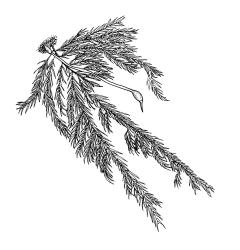Elements in the following description are taken from Ramsay et al. (2002).
Plants small to moderately robust, dull or ± glossy, bright-, yellow-, white-, gold- or brown-green, forming interwoven mats or rarely caespitose. Stems creeping, ± red, irregularly to pinnately branched. Branches erect-ascendant, crowded, often curved, sometimes cuspidate in N.Z. species. Branch and stem leaves similar, appressed, erect-spreading, homomallous or falcate-secund, ovate-lanceolate or oblong, acute to acuminate, denticulate or entire, concave or rarely tubulose; mid laminal cells (upper third of leaf) rhomboidal, oval-oblong, fusiform, or linear-vermicular, l:w ratio variable, to c. 20:1, smooth; alar cells abruptly differentiated, mostly enlarged and inflated in extreme corners, firm- or thin-walled, supra-alar cells mostly small and ± quadrate. Costa short and double or lacking.
Autoicous or rarely dioicous. Perichaetia scattered on stems, and with perichaetial leaves differentiated, rarely sheathing the setae. Setae elongate, ± red, smooth or mammillate-scabrous; capsules pendulous or horizontal or rarely suberect (as in S. homomallum), ovoid to oblong-cylindric, with a short and ill-defined neck, which sometimes has wart-like protuberances in N.Z. species, mostly constricted below the mouth when dry and little altered with moist; stomata restricted to neck, sometimes confined to wart-like protuberances; annulus not differentiated; operculum slenderly rostrate from a conic base; exothecial cells mostly short-oblong or ± quadrate, strongly thickened in corners or with thickened longitudinal walls and thinner transverse walls (subcollenchymatous). Peristome double, pale; exostome teeth 16, strongly shouldered and bordered, the outer surface cross-striolate below and with a median zig-zag line, the inner surface trabeculate; endostome with a high (rarely ± low) basal membrane and mostly keeled and perforate segments nearly as long as the teeth; cilia 0–2. Calyptra cucullate, smooth, naked. Spores spherical, small- to medium-sized, green in N.Z. species.
A very large genus of more than 200 species (Ramsay et al. 2002) distributed in tropical and temperate regions worldwide. Five species are recognised from N.Z.
The N.Z. species are variable and consequently some less well-developed specimens, especially those lacking sporophytes, can pose problems of identification.
Buck (1998, p. 368) referred to Sematophyllum as "scarcely more than the dregs of the Sematophyllaceae" and considered the genus to be "characterized by the lack of various specialised features. It has non-papillose laminal cells, non-furrowed exostome teeth, mostly non-erect capsules with little or no endostomal reduction, and exothecial cells not thin-walled." I concur with Buck. The N.Z. species are a heterogeneous and probably polyphyletic assemblage, but the genus continues to serve a useful taxonomic function.
The generic segregates of Rhaphidorrhynchium and Warburgiella advocated by Ramsay et al. (2002, 2004) for Australia are adopted here.
Sematophyllum subpinnatum (Brid.) E.Britt. is a widespread species in tropical and warm-temperate regions worldwide that is reported from eastern Australia (Ramsay et al. 2002). Because of its wide distribution, occurrence in northern parts of N.Z. is probable. It could be recognised by having a growth form similar to that of S. subhumile var. contiguum but with duller colouration, broader leaves with more distinctly recurved margins, and shorter (mostly 4–6:1) mid laminal cells.
| Category | Number |
|---|---|
| Indigenous (Endemic) | 2 |
| Indigenous (Non-endemic) | 4 |
| Total | 6 |




